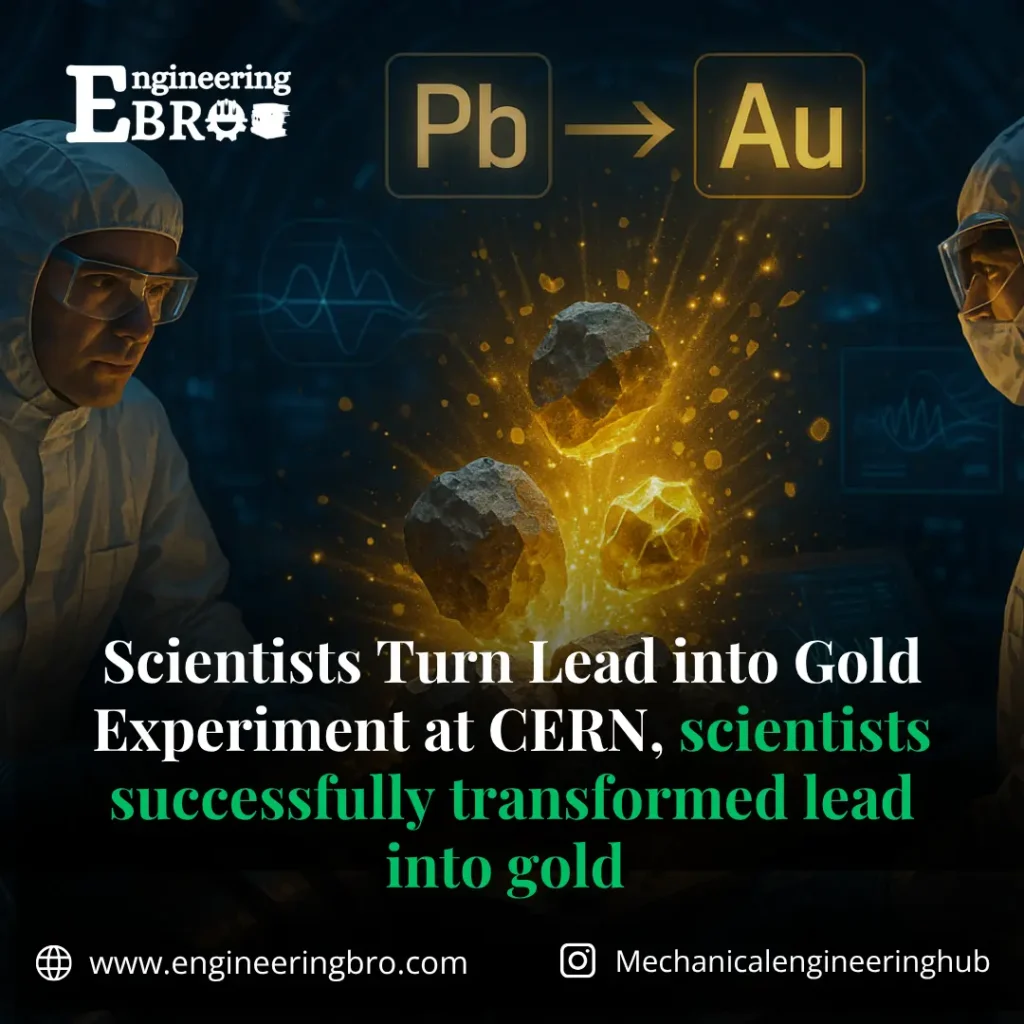In this post, we’ll explain how scientists turn lead into gold transformation, why it’s important, and what it could mean for the future.
Introduction: From Myth to Modern Physics
For centuries, people dreamed of turning simple metals like lead into gold. This idea came from old traditions called alchemy. In 2025, scientists at CERN‘s Large Hadron Collider (LHC) did something incredible—they managed to change lead into gold at the tiniest level, even if just for a moment. This major scientific success shows how far modern science has come.

Table of Contents
The Ancient Dream: Turning Lead into Gold
Long ago, alchemists in Europe, the Middle East, and Asia wanted to find a magical object called the philosopher’s stone. They believed it could change cheap metals like lead into valuable gold. While their methods weren’t scientific, the dream lived on.
With the rise of modern science, the idea of changing one element into another became a real possibility—but it’s still very hard to do. Changing an element means changing its atomic structure, which takes a lot of energy and the right tools.
Modern Science Makes It Happen at CERN
In May 2025, scientists from the ALICE team at CERN announced they had turned lead into gold. Here’s how they did it:
- The experiment used data from Run 2 of the LHC (2015–2018).
- They made lead atoms move at high speed and just miss each other.
- This near-collision created powerful electromagnetic fields.
- These fields knocked three protons out of the lead atom.
- When that happened, the atom changed from lead (82 protons) to gold (79 protons).
This is called electromagnetic dissociation. It was the first time this process was clearly observed in this way.
Who Were the Scientists Behind This?
The experiment was done by the ALICE collaboration, which includes over 2,000 scientists from around the world. Some of the key people were:
- Uliana Dmitrieva – helped design the experiment and study the data.
- Marco van Leeuwen – spokesperson for the team.
- John Jowett – worked on understanding the LHC’s beam behavior.
Their research was published in a scientific journal on May 7, 2025.
How the Process Works: A Simple Explanation
Let’s break it down simply:
- Lead atoms have 82 protons.
- In the experiment, lead atoms flew past each other very fast.
- The passing created powerful energy that removed 3 protons.
- The new atom had 79 protons—that’s gold.
This didn’t require smashing atoms directly. Just the energy from being close was enough to cause the change. But the gold didn’t last—it was unstable and broke down quickly.
How Much Gold Was Made?
- During the entire Run 2, about 86 billion gold atoms were created.
- But their total weight was only 29 picograms (a trillionth of a gram).
- Almost all of them broke apart quickly.
So yes, scientists really did turn lead into gold—but only a tiny, tiny amount.
Why Is This Important?
Even though we can’t make money from this process, the experiment still matters:
- Beam control: Helps scientists improve how they run particle accelerators.
- Nuclear understanding: Teaches us how atoms behave in extreme conditions.
- Astrophysics: Similar reactions happen in space during star explosions.
- Symbolism: Achieving an ancient goal with modern science shows how far we’ve come.
Why We Can’t Use This to Make Real Gold
- Too expensive: Running the LHC costs billions.
- Very small results: Only a microscopic amount of gold was made.
- Too unstable: The gold atoms don’t last long enough to use.
This process will never replace traditional gold mining or be used to make wealth.
A Closer Look at Electromagnetic Dissociation
This was the first time scientists clearly saw electromagnetic dissociation happen this way:
- It happens when atoms come very close but don’t touch.
- The energy from this near-miss can change the atoms.
- This method is useful for studying nuclear reactions in a new way.
What’s Next in This Field?
This experiment won’t change the economy, but it could:
- Help improve particle accelerator designs.
- Teach us more about how atoms work.
- Encourage new discoveries in physics and chemistry.
- Be used in science education.
The ALICE team’s work shows what can happen when powerful machines and smart people work together.
Conclusion: A Dream Becomes Reality—In Science
Turning lead into gold is no longer just a myth—it’s now a scientific fact, even if it only happens briefly and in tiny amounts. The experiment at CERN shows how far science has come and gives us new ways to explore the building blocks of the universe.
This isn’t about getting rich—it’s about getting smarter. It proves that ancient dreams can come true with modern tools, not magic. And that’s the real gold of science.
